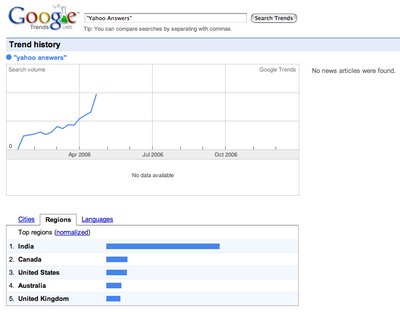Yahoo! Answers was one of the last projects that I worked on when I was inhouse, I will hold my hand up and admit that I was a hawk in the Yahoo! Answers team. The reasons for my Yahoo! Answers hawk status in terms of the product being a ‘killer application’ was mainly because it failed my own ‘test’ of how is this relevant to my online life. It also suffered from the Yahoo! services problem of an off-putting onboarding process. If you weren’t put off by the sign-up then would be greeted by a product that would be familiar to business online support services. The prototypes that I saw internally reminded me of the self service customer solutions offered by the likes of RightNow Technologies and Transversal and the support forums provided by Apple for users.
I thought that the opportunity may be in sponsored channels: Microsoft sponsoring an XBox channel, or Sainsbury’s sponsoring a recipe channel. But this was poo-pooed as an idea by my immediate director.

In some ways I was wrong about Yahoo! Answers success (and I am happy to be wrong in this case).Windows Live QnA doesn’t seem to have gone anywhere, Lycos IQ: though superior in terms of design and features doesn’t seem to have got that much traction so far.
According to Hitwise (via SearchEngineWatch), Yahoo! Answers is now the third most popular reference site online, however its 2.94 per cent market share is puny in comparision to the 16.76 per cent marketshare of Wikipedia which has a Googlesque sector dominance.
Steve Rubel has talked about Yahoo! Answers on his MicroPersuasion blog Marketers will Answer to Yahoo! and sees the opportunity for sponsored sections, which kind of squares the circle in the way that I viewed the product.
It offers yet another opportunity for direct interaction with consumers and a channel for cummunications, but not a full-on dialogue.
Where it gets interesting is when you look at the Google Trends data on the service, most of the search enquiries for Yahoo! Answers seems to be coming out of India, rather than the US or Europe. This will alter the services attraction for advertisers in terms of the net worth of the consumer, whether they can capitalise on the clicks through presence in the marketplace and the quality of answers given for a global audience – quality control will be a critical ongoing issue.
In addition, where similar services have been provided in the US before, they haven’t made much of an impact. More related posts here.

